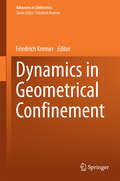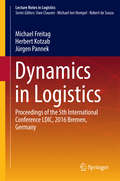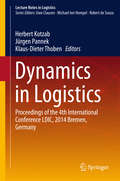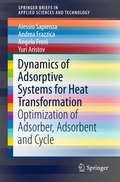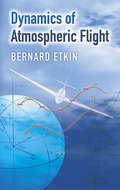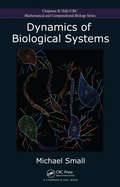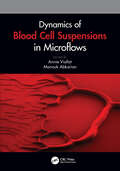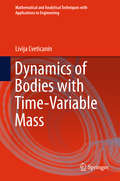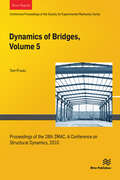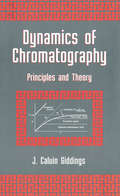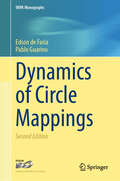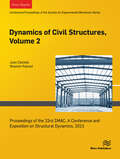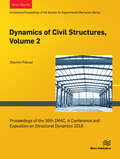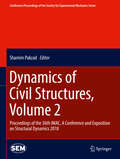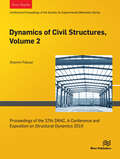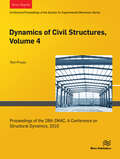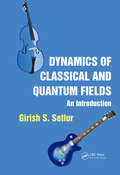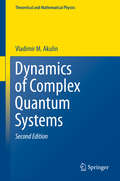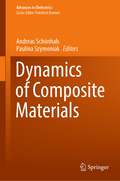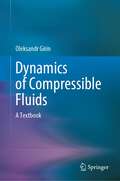- Table View
- List View
Dynamics in Geometrical Confinement
by Friedrich KremerThis book describes the dynamics of low molecular weight and polymeric molecules when they are constrained under conditions of geometrical confinement. It covers geometrical confinement in different dimensionalities: (i) in nanometer thin layers or self supporting films (1-dimensional confinement) (ii) in pores or tubes with nanometric diameters (2-dimensional confinement) (iii) as micelles embedded in matrices (3-dimensional) or as nanodroplets. The dynamics under such conditions have been a much discussed and central topic in the focus of intense worldwide research activities within the last two decades. The present book discusses how the resulting molecular mobility is influenced by the subtle counterbalance between surface effects (typically slowing down molecular dynamics through attractive guest/host interactions) and confinement effects (typically increasing the mobility). It also explains how these influences can be modified and tuned, e. g. through appropriate surface coatings, film thicknesses or pore diameters. "Dynamics in Confinement" sums up the present state-of-the-art and introduces to the analytical methods of choice for the study of dynamics in nanometer-scale confinement.
Dynamics in Logistics
by Jürgen Pannek Herbert Kotzab Michael FreitagThese proceedings contain research papers presented at the 5th International Conference on Dynamics in Logistics, held in Bremen, Germany, February 2016. The conference is concerned with dynamic aspects of logistic processes and networks. The spectrum of topics reaches from modeling, planning and control of processes over supply chain management and maritime logistics to innovative technologies and robotic applications for cyber-physical production and logistic systems. The growing dynamic confronts the area of logistics with completely new challenges: it must become possible to describe, identify and analyze the process changes. Moreover, logistic processes and networks must be redevised to be rapidly and flexibly adaptable to continuously changing conditions. The book primarily addresses researchers and practitioners from the field of industrial engineering and logistics, but it may also be beneficial for graduate students.
Dynamics in Logistics
by Jürgen Pannek Herbert Kotzab Klaus-Dieter ThobenThis contributed volume brings together research papers presented at the 4th International Conference on Dynamics in Logistics, held in Bremen, Germany in February 2014. The conference focused on the identification, analysis and description of the dynamics of logistics processes and networks. Topics covered range from the modeling and planning of processes, to innovative methods like autonomous control and knowledge management, to the latest technologies provided by radio frequency identification, mobile communication, and networking. The growing dynamic poses wholly new challenges: logistics processes and networks must be(come) able to rapidly and flexibly adapt to constantly changing conditions. The book primarily addresses the needs of researchers and practitioners from the field of logistics, but will also be beneficial for graduate students.
Dynamics in Microwave Chemistry
by Kama Huang Xiaoqing Yang Huacheng ZhuThis book addresses microwave chemistry at both the physical and molecular level. Its main goal is to elaborate the highly complex scientific issues involved in the fundamental theory of microwave chemistry, and in industrialized applications in the near future.The book provides detailed insights into the characterization and measurement of dielectric properties under complex conditions, such as chemical reactions, high-temperature environments, etc. Considerable attention is paid to the theory of dynamics in microwave chemistry, from the view of both physical level and molecular level. Microwave-Material Interactions simulation is used for physical dynamical analysis, while a Microwave-Molecules Interactions methodology is proposed for molecular dynamical analysis. In turn, calculational examples are introduced for better description and validation, respectively. Lastly, the book proposes design strategies and calculational examples for large-scale application.Richly illustrated and including a wealth of worked-out examples, this book is ideal for all researchers, students and engineers who are just getting started in the dynamics of microwave chemistry.
Dynamics of Adsorptive Systems for Heat Transformation: Optimization Of Adsorber, Adsorbent And Cycle (SpringerBriefs in Applied Sciences and Technology)
by Angelo Freni Andrea Frazzica Alessio Sapienza Yuri AristovThis book investigates the adsorption dynamics of water, methanol, ethanol, and ammonia vapor on loose and consolidated adsorbent beds, as well as the impact of this aspect on the overall performance of adsorption systems for heat transformation. In particular, it presents the results of kinetic measurements made using the large temperature jump (LTJ) method, the most efficient way to study adsorption dynamics under realistic operating conditions for adsorptive heat transformers. The information provided is especially beneficial for all those working on the development of novel adsorbent materials and advanced adsorbers for heating and cooling applications. Today, technologies and systems based on adsorption heat transformation (AHT) processes offer a fascinating option for meeting the growing worldwide demand for air conditioning and space heating. Nevertheless, considerable efforts must still be made in order to enhance performance so as to effectively compete with commonly used electrical compression and absorption machines. For this purpose, intelligent design for adsorption units should above all focus on finding a convenient choice of adsorbent material by means of a comprehensive analysis that takes into account both thermodynamic and dynamic aspects. While the thermodynamic properties of the AHT cycle have been studied extensively, the dynamic optimization of AHT adsorbers is still an open issue. Several efforts have recently been made in order to analyze AHT dynamics, which greatly influence overall AHT performance.
Dynamics of Atmospheric Flight (Dover Books on Aeronautical Engineering)
by Bernard EtkinGeared toward upper-level undergrads, graduate students, and practicing engineers, this comprehensive treatment of the dynamics of atmospheric flight focuses especially on the stability and control of airplanes. An extensive set of numerical examples covers STOL airplanes, subsonic jet transports, hypersonic flight, stability augmentation, and wind and density gradients.The equations of motion receive a very full treatment, including the effects of the curvature and rotation of the Earth and distortional motion. Complete chapters are given to human pilots and handling qualities and to flight in turbulence, with numerical examples for a jet transport. Small-perturbation equations for longitudinal and lateral motion appear in convenient matrix forms, both in time-domain and Laplace transforms, dimensional and nondimensional.
Dynamics of Bacteria-Mucus Interactions (Methods in Molecular Biology #2942)
by Inka BrockhausenThis volume details the importance of bacteria in and around the human body, highlighting the bacteria that is harmless and pathogenic bacteria. Chapters guide readers through protocols on different bacteria&’s providing a better understand on they operate and how people can protect ourselves. Written in the highly successful Methods in Molecular Biology series format, the chapters include brief introductions to the material, lists of necessary materials and reagents, step-by-step, readily reproducible laboratory protocols, and a Notes section which highlights tips on troubleshooting and avoiding known pitfalls. Authoritative and cutting-edge, Dynamics of Bacteria-Mucus Interactions aims to be comprehensive guide for researchers in the field.
Dynamics of Biological Systems (Chapman & Hall/CRC Computational Biology Series)
by Michael SmallFrom the spontaneous rapid firing of cortical neurons to the spatial diffusion of disease epidemics, biological systems exhibit rich dynamic behaviour over a vast range of time and space scales. Unifying many of these diverse phenomena, Dynamics of Biological Systems provides the computational and mathematical platform from which to understand the
Dynamics of Blood Cell Suspensions in Microflows
by Annie Viallat and Manouk AbkarianBlood microcirculation is essential to our bodies for the successful supply of nutrients, waste removal, oxygen delivery, homeostasis, controlling temperature, wound healing, and active immune surveillance. This book provides a physical introduction to the subject and explores how researchers can successfully describe, understand, and predict behaviours of blood flow and blood cells that are directly linked to these important physiological functions. Using practical examples, this book explains how the key concepts of physics are related to blood microcirculation and underlie the dynamic behavior of red blood cells, leukocytes, and platelets. This interdisciplinary book will be a valuable reference for researchers and graduate students in biomechanics, fluid mechanics, biomedical engineering, biological physics, and medicine. Features: The first book to provide a physical perspective of blood microcirculation Draws attention to the potential of this physical approach for novel applications in medicine Edited by specialists in this field, with chapter contributions from subject area specialists
Dynamics of Bodies with Time-Variable Mass
by Livija CveticaninThis book deals with the problem of dynamics of bodies with time-variable mass and moment of inertia. Mass addition and mass separation from the body are treated. Both aspects of mass variation, continual and discontinual, are considered. Dynamic properties of the body are obtained applying principles of classical dynamics and also analytical mechanics. Advantages and disadvantages of both approaches are discussed. Dynamics of constant body is adopted, and the characteristics of the mass variation of the body is included. Special attention is given to the influence of the reactive force and the reactive torque. The vibration of the body with variable mass is presented. One and two degrees of freedom oscillators with variable mass are discussed. Rotors and the Van der Pol oscillator with variable mass are displayed. The chaotic motion of bodies with variable mass is discussed too. To support learning, some solved practical problems are included.
Dynamics of Bridges, Volume 5: Proceedings of the 28th IMAC, A Conference on Structural Dynamics, 2010
by Tom ProulxThis the fifth volume of five from the 28th IMAC on Structural Dynamics and Renewable Energy, 2010, brings together 19 chapters on the Dynamics of Bridges. It presents early findings from experimental as well as computational investigations on the Dynamics of Bridges, including studies on Modeling Environmental Effects on the Dynamic Characteristics of the Tamar Suspension, Structural Health Monitoring of Bridges, Structural Assessment of Damaged Bridges Using Ambient Vibration Testing, and Development of a Tamar Bridge Finite Element Model.
Dynamics of Cell Fate Decision Mediated by the Interplay of Autophagy and Apoptosis in Cancer Cells
by Iman TavassolyThis interdisciplinary thesis introduces a systems biology approach to study the cell fate decision mediated by autophagy. A mathematical model of interaction between Autophagy and Apoptosis in mammalian cells is proposed. In this dynamic model autophagy acts as a gradual response to stress (Rheostat) that delays the initiation of bistable switch of apoptosis to give the cells an opportunity to survive. The author shows that his dynamical model is consistent with existing quantitative measurements of time courses of autophagic responses to cisplatin treatment. To understand the function of this response in cancer cells, he has provided a systems biology experimental framework to study quantitative and dynamical aspects of autophagy in single cancer cells using live-cell imaging and quantitative fluorescence microscopy. This framework can provide new insights on function of autophagic response in cancer cells.
Dynamics of Chromatography: Principles and Theory
by J. Calvin GiddingsThis classic and bestselling landmark publication, originally published in 1965, examines the dynamic mechanisms, fundamental principles, and physical properties of various chromatographic procedures. It offers methods to characterize, identify, and predict chromatographic phenomena - providing strategies to select the most appropriate separation tools and techniques for specific applications in chemistry, physics, biology, and forensic and environmental science.Written by a world-renowned pioneer in the field, Dynamics of Chromatography contains many worked equations and real-world examples in gas and liquid chromatography. It includes numerous schematic figures for visualization of key concepts, introduces the means to control migration rate differences and zone spreading, and presents a detailed random-walk model for clarification of column processes. It also analyzes flow, diffusion, and kinetic events, stresses the link between theory and practice, and summarizes mathematical quantities and parameters.
Dynamics of Circle Mappings (IMPA Monographs)
by Pablo Guarino Edson de FariaThis book explores recent developments in the dynamics of invertible circle maps, a rich and captivating topic in one-dimensional dynamics. It focuses on two main classes of invertible dynamical systems on the circle: global diffeomorphisms and smooth homeomorphisms with critical points. The latter is the book's core, reflecting the authors' recent research interests.Organized into four parts and 14 chapters, the content covers rigid rotations, circle homeomorphisms, and the concept of rotation number in the first part. The second part delves into circle diffeomorphisms, presenting classical results. The third part introduces multicritical circle maps—smooth homeomorphisms of the circle with a finite number of critical points. The fourth and final part centers on renormalization theory, analyzing the fine geometric structure of orbits of multicritical circle maps. Complete proofs for several fundamental results in circle dynamics are provided throughout. The book concludes with a list of open questions.Primarily intended for graduate students and young researchers in dynamical systems, this book is also suitable for mathematicians from other fields with an interest in the subject. Prerequisites include familiarity with the content of a standard graduate course in real analysis, along with some understanding of ergodic theory and dynamical systems. Basic knowledge of complex analysis is needed for specific chapters.
Dynamics of Civil Structures, Vol. 2: Proceedings of the 42nd IMAC, A Conference and Exposition on Structural Dynamics 2024 (Conference Proceedings of the Society for Experimental Mechanics Series)
by Matthew Whelan P. Scott Harvey Fernando MoreuDynamics of Civil Structures, Volume 2: Proceedings of the 42nd IMAC, A Conference and Exposition on Structural Dynamics, 2024, the second volume of ten from the Conference brings together contributions to this important area of research and engineering. The collection presents early findings and case studies on fundamental and applied aspects of the Dynamics of Civil Structures, including papers on: Structural Vibration Dynamics of Bridges, Buildings, and Infrastructure Systems Innovative Sensors and Measurement Techniques for Structural Applications Structural Control and Vibration Mitigation Human Induced Vibrations and Human-Structure Interaction Modal Identification of Structural Systems Human Health Monitoring Using Structural Sensing Field Monitoring of Vibrations
Dynamics of Civil Structures, Volume 2: Proceedings of the 33rd IMAC, A Conference and Exposition on Structural Dynamics, 2015
by Shamim Pakzad Juan CaicedoDynamics of Civil Structures, Volume 2. Proceedings of the 33rd IMAC, , A Conference and Exposition on Balancing Simulation and Testing, 2015, the second volume of ten from the Conference brings together contributions to this important area of research and engineering. The collection presents early findings and case studies on fundamental and applied aspects of Structural Dynamics, including papers on: Modal Parameter Identification Dynamic Testing of Civil Structures Human Induced Vibrations of Civil Structures Correlation & Updating Operational Modal Analysis Damage Detection of Structures Bridge Structures Damage Detection Models Experimental Techniques for Civil Structures.
Dynamics of Civil Structures, Volume 2: Proceedings of the 36th IMAC, A Conference and Exposition on Structural Dynamics 2018
by Shamim PakzadDynamics of Civil Structures, Volume 2: Proceedings of the 36th IMAC, A Conference and Exposition on Structural Dynamics, 2018, the second volume of nine from the Conference brings together contributions to this important area of research and engineering. The collection presents early findings and case studies on fundamental and applied aspects of the Dynamics of Civil Structures, including papers on: Modal Parameter Identification Dynamic Testing of Civil Structures Control of Human Induced Vibrations of Civil Structures Model Updating Damage Identification in Civil Infrastructure Bridge Dynamics Experimental Techniques for Civil Structures Hybrid Simulation of Civil Structures Vibration Control of Civil Structures System Identification of Civil Structures.
Dynamics of Civil Structures, Volume 2: Proceedings of the 36th IMAC, A Conference and Exposition on Structural Dynamics 2018 (Conference Proceedings of the Society for Experimental Mechanics Series)
by Shamim PakzadDynamics of Civil Structures, Volume 2: Proceedings of the 36th IMAC, A Conference and Exposition on Structural Dynamics, 2018, the second volume of nine from the Conference brings together contributions to this important area of research and engineering. The collection presents early findings and case studies on fundamental and applied aspects of the Dynamics of Civil Structures, including papers on: Modal Parameter IdentificationDynamic Testing of Civil StructuresControl of Human Induced Vibrations of Civil StructuresModel UpdatingDamage Identification in Civil InfrastructureBridge DynamicsExperimental Techniques for Civil StructuresHybrid Simulation of Civil StructuresVibration Control of Civil StructuresSystem Identification of Civil Structures
Dynamics of Civil Structures, Volume 2: Proceedings of the 37th IMAC, A Conference and Exposition on Structural Dynamics 2019
by Shamim PakzadDynamics of Civil Structures, Volume 2: Proceedings of the 37th IMAC, A Conference and Exposition on Structural Dynamics, 2019, the second volume of eight from the Conference brings together contributions to this important area of research and engineering. The collection presents early findings and case studies on fundamental and applied aspects of the Dynamics of Civil Structures, including papers on: Structural Vibration Humans & Structures Innovative Measurement for Structural Applications Smart Structures and Automation Modal Identification of Structural Systems Bridges and Novel Vibration Analysis Sensors and Control Similar content being view.
Dynamics of Civil Structures, Volume 2: Proceedings of the 37th IMAC, A Conference and Exposition on Structural Dynamics 2019 (Conference Proceedings of the Society for Experimental Mechanics Series)
by Shamim PakzadDynamics of Civil Structures, Volume 2: Proceedings of the 37th IMAC, A Conference and Exposition on Structural Dynamics, 2019, the second volume of eight from the Conference brings together contributions to this important area of research and engineering. The collection presents early findings and case studies on fundamental and applied aspects of the Dynamics of Civil Structures, including papers on:Structural Vibration Humans & Structures Innovative Measurement for Structural Applications Smart Structures and Automation Modal Identification of Structural Systems Bridges and Novel Vibration Analysis Sensors and Control
Dynamics of Civil Structures, Volume 4: Proceedings of the 28th IMAC, A Conference on Structural Dynamics, 2010
by Tom ProulxThis the fourth volume of five from the 28th IMAC on Structural Dynamics and Renewable Energy, 2010, brings together 29 chapters on the Dynamics of Civil Structures. It presents early findings from experimental and computational investigations of Civil Structures, including studies such as Characterization of a Strongly Nonlinear Laboratory Benchmark System, A Non-destructive Technique for the Health Monitoring of Tie-rods in Ancient Buildings, Estimating Effective Prestress Force on Grouted Tendon by Impact Responses, Experimental Investigation of Dynamic Load Estimation Using Small-scale Testing, and Prediction of Prestress Force on Grouted Tendon by Experimental Modal Analysis.
Dynamics of Classical and Quantum Fields: An Introduction
by Girish S. SetlurDynamics of Classical and Quantum Fields: An Introduction focuses on dynamical fields in non-relativistic physics. Written by a physicist for physicists, the book is designed to help readers develop analytical skills related to classical and quantum fields at the non-relativistic level, and think about the concepts and theory through numerous probl
Dynamics of Complex Quantum Systems
by Vladimir M. AkulinThis book gathers together a range of similar problems that can be encountered in different fields of modern quantum physics and that have common features with regard to multilevel quantum systems. The main motivation was to examine from a uniform standpoint various models and approaches that have been developed in atomic, molecular, condensed matter, chemical, laser and nuclear physics in various contexts. The book should help senior-level undergraduate, graduate students and researchers putting particular problems in these fields into a broader scientific context and thereby taking advantage of well-established techniques used in adjacent fields. This second edition has been expanded to include substantial new material (e. g. new sections on Dynamic Localization and on Euclidean Random Matrices and new chapters on Entanglement, Open Quantum Systems, and Coherence Protection). It is based on the author's lectures at the Moscow Institute of Physics and Technology, at the CNRS Aimé Cotton Laboratory, and on other courses he has given over the last two decades.
Dynamics of Composite Materials (Advances in Dielectrics)
by Andreas Schönhals Paulina SzymoniakThe book presents recent developments in the field of composites, investigated by Broadband Dielectric Spectroscopy (BDS) and sheds a special focus on nanocomposites. This volume compares the results obtained by BDS with data from other methods like hyphenated calorimetry, dynamical-mechanical spectroscopy, NMR spectroscopy and neutron scattering. The addressed systems range from all kinds of model systems, such as polymers filled with spherical silica particles, advanced materials such as polymers with molecular stickers or hyperbranched polymer-based matrices to industrially significant systems, like epoxy-based materials. The book offers an excellent insight to a valuable application of dielectric spectroscopy and it is a helpful guide for every scientist who wants to study dynamics in composite materials.
Dynamics of Compressible Fluids: A Textbook
by Oleksandr GirinCompressibility is a property inherent in any material, but it does not always manifest itself. Experience suggests that it affects the medium motion only at velocities comparable to the speed of sound. Why do we study compressibility? It turns out that in order to calculate the aircraft streamlining or the internal flow in its engine, or the shell muzzle velocity, or the dynamic load of a shock wave from an accidental blast on a structural element, and in many other cases it is necessary to know and understand the laws of the Dynamics of Compressible Media (DCM) and be able to apply them in practice. This textbook is designed to help readers achieve this goal and learn the basics of DCM. This field of knowledge is high-tech and always focuses on the future: modern developments of hypersonic aircraft, designing more advanced structural elements for airplanes and helicopters, calculating the car aerodynamics, etc. Paradoxes have always given impetus to the search for new technological devices. Unusual effects in DCM include the flow chocking in supersonic outflow from reservoirs (Sect.2.2); the shock wave formation inside an initially smooth flow (Sect.5.3); the generation of a "spallation saucer" of armor inside a tank when a shell hits it (Sect.5.5); the dog-leg of a plane discontinuity surface at shockwave reflection from a rigid wall (Sec.8.1). The way to understand these and other effects is through the creation of quantitative models of a moving compressible fluid.
